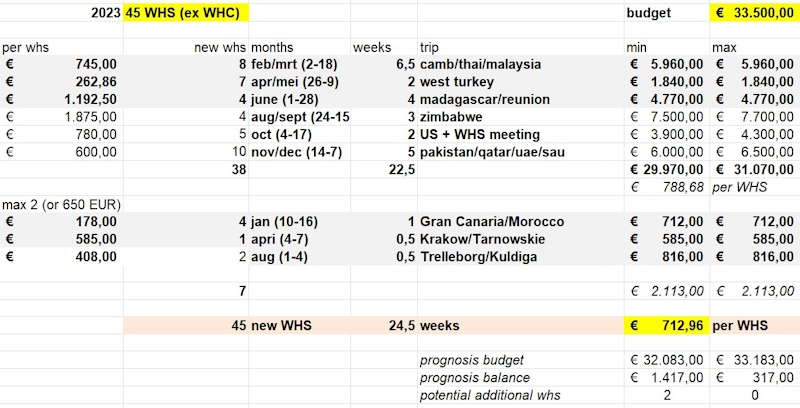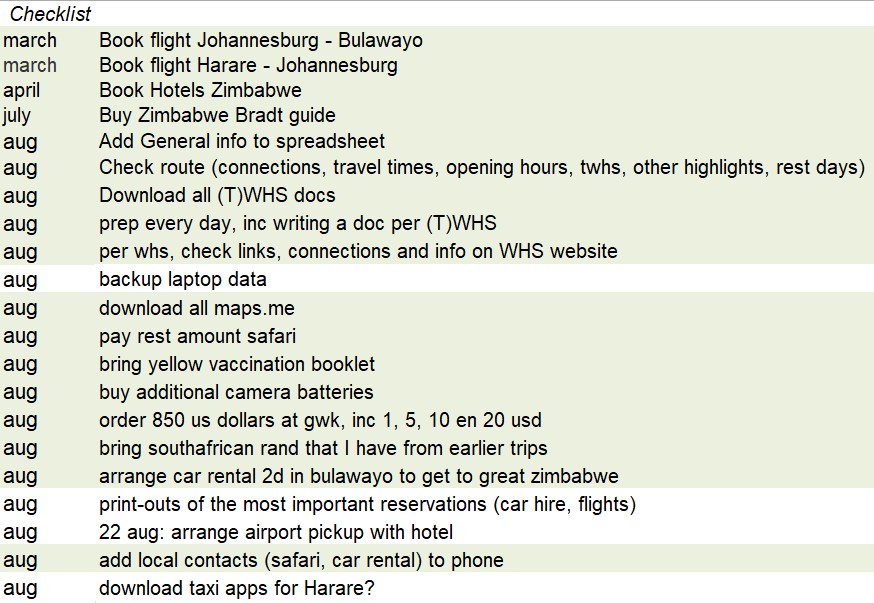Blog Travel in general
Parallel planning of multiple trips
Travel Planning is a subject close to my heart and I’ve written about WH Trip planning before.
That was already 7 years ago and I must say that my approach has changed a bit, mostly because my personal situation has changed. I now am in the position to dedicate all my time to travel. I constantly have at least three larger trips in full preparation for the coming half year and am looking already ahead to the year after. But planning multiple longer trips in parallel has proven to be a skill in itself. Here is how I have managed over the past 2 years.
Setting a yearly budget and managing it
As money is the main limiting factor, I start by setting a travel budget for the whole year. This is fixed, unless I get some bonuses like unexpected tax returns during the year.
Based on that budget, I try to plan ca. 6 longer and 2 or 3 shorter trips. The longer ones are mainly clusters with more than 3 WHS, taken from my ‘Triplist towards 1100 WHS before 2030’. I bring them all together with rough cost estimates:

The trips in the grey lines already lie in the past and thus provide the exact ‘results’, while the white lines are estimates for the remaining trips of 2023.
As can be seen at the top left of the table, I also aim at a certain amount of ‘new’ WHS. This is in order to keep my progress towards the 1,100 visited WHS. Another important KPI is the ‘Cost per WHS’ (bottom right) – I aim for 650 EUR, also to get to 1,100 WHS without running out of money beforehand. As you can see I will overspend a bit this year on per WHS-basis due to a couple of expensive destinations, but I am still within my overall travel budget.
Planning the individual trips following a pattern
Ideas for future longer trips linger in the general spreadsheet, aptly called ‘Travel’, but when I have decided to go for a specific trip it will get its own spreadsheet. This consists of the following worksheets:
1. Plan – this is the day-to-day itinerary, a row for each day including what I plan to do, and where I will stay (town+hotel name). It also includes a first calculation of the costs and the full To-do list during the planning stage.
2. Cost – Day-to-day overview of the costs, to be filled in during the trip. Categories include Hotels/Transport/Food/Tours&Entrance/Other. I fill it in the local currency and it converts to EUR and into a general overview table with the overall costs at the end of the trip.
3. General – This contains a few subjects that I always research beforehand: Time Zones, Money, Weather, Visa, Plug, Medical, Sim. It is done by country (so if a trip includes multiple countries, I have multiple General sheets).
4. Bring – a standard list of items that I take with me, later customized to fit the specific trip.
Regularly picking tasks from the To-do lists
The most intensive list to manage in this spreadsheet is the Planning To-do list, which looks like this:

This planning list uses standard tasks that I execute every trip, such as downloading all maps.me maps of the areas I will be visiting and downloading all official documentation for the (T)WHS. Each trip has specific tasks as well of course, for my upcoming trip to Zimbabwe for example “order US dollars” and “buy additional camera batteries”.
As can be gathered from the example above, I book the basics such as flights, (cancellable) hotels and rental cars some 3-6 months ahead. I will then already have a global day-to-day plan, taking into account travel times and specific opening hours. In the last month before travel, I fill in the details and then sometimes switch around a few days and rebook hotels. I then also do more detailed research on the WHS and put the output in a document per WHS, which later will become the basis for my review of that WHS. This process has stayed the same as in 2016, described in step #5 then.
Things I am still struggling with
- I would like to spend a higher percentage of the year abroad, but somehow I don't manage. This is probably due to choosing more expensive destinations lately, but also because the cheapish clusters have already gone when you’re at 800+ WHS.
- So far I do all my planning in Excel – I have not found a more suitable tool yet. One of the main issues is that the planning of all trips is not integrated. So I have to open the Zimbabwe spreadsheet to see the open tasks there, and the US spreadsheet to see its open tasks for the same period. I have used Jira before for task management, but it isn't as versatile as Excel.
Overall I am happy with my system, but I understand that ‘needing’ this level of control is not for everyone. On the plus side: I make very few mistakes and have never missed out on a planned WHS visit since I started it. I only lost some money earlier this year when I had originally wanted to include Indonesia in my Cambodia/Thailand/Malaysia trip, but had overlooked the dates of Ramadan (and spending the full Ramadan in the Islamic parts of Indonesia did not sound like fun to me).
Do you have tips to share about how to manage multiple trips in parallel?
Els - 27 August 2023
Comments
Shandos 1 September 2023
I also mainly use Excel for trip planning, in conjunction with Evernote. (For trips fully or partially planned in advance, I usually do a detailed daily itinerary.)
One other thing I've used for my database of unvisited sites is Airtable - I had a lot of time for research during Covid!
Philipp Peterer 30 August 2023
Very interesting to read how this looks on a more professional level. I don't have a budget calculation at all, as due to limited holidays and family obligations my scarce ressource is time. I have an excel with several weekend-, day- and 3/4-days trips I can pull out if I have the magic constellation of time, flights and good weather. These trips are planned by the hour. For longer trips I plan the itinerary usually (too) late.
Wojtek 27 August 2023
I rarely have such a problem, usually I start planning another scheduled trip after the previous one is finished. I have a general checklist which serves for all trips, it includes renting a car, downloading maps, exchanging money etc. The most time-consuming part is always planning a detailed route.